Is innocence a deep seated habit, a synthetic DNA of being in denial of what one knows but steadfastly refuses to acknowledge? Is innocence a manufactured good? A commodity among many competitors? Its a disabling of experience. Its one of Freud’s central hypotheses: the primary function of consciousness is not to accept stimuli, to be absorbed by it, but instead, to attain protection from it. here is a space between between this unconscious memory and an awareness of the conscious act of recollection. Is it as Richard Halpern has asserted, ” the containment of the perverse under the sign of the normal.”

"In disavowal, however, consciousness both retains and banishes something. It thereby allows itself to enjoy that forbidden thing on the sly while denying that it enjoys or knows it. Disavowal is not exactly a way of having your cake and eating it too. It’s rather a way of eating your cake and nevertheless being able to deny to yourself, with apparent sincerity, that you ever ate it or had any intention of doing so. Indeed, it’s a way of eating cake while declaring that people who eat cake are disgusting and ought to be locked up. " Read More: http://www.press.uchicago.edu/Misc/Chicago/314405.html image: http://childillustration.blogspot.com/2010/08/norman-rockwell-april-fool-girl-with.html
On one part, there is an assertion that abandoning traces of memory is repulsive, yet a counterclaim exists that consciousness will defend against the barrage of dings, bangs and shocks that menace the organism’s defense from without. In inability to filter this shock through the layers of padding, leads to the creation of trauma, which by that time is severe. The theory is that what saves the individual is the mediation process through substitutes and vicarious measures which protect, if only partially and may create its own mutant form of trauma.
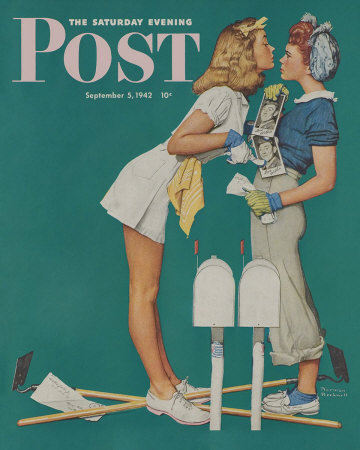
"We learn to disavow in many ways from a very early age, and our different forms of disavowal soon become hopelessly entangled. But sexual disavowal is nevertheless a very potent form of it, and people under the sway of sexual disavowal are, more often than not, unusually vulnerable to other forms as well." Read More: http://www.press.uchicago.edu/Misc/Chicago/314405.html image: http://www.best-norman-rockwell-art.com/1942-willie-gillis-girls-with-letters.html
According to Freud, terror, anxiety and panic arises when the consciousness can no longer deliver on its function of protection. Charles Baudelaire offers impressive images which can be understood with the help of Freud’s hypothesis. He often speaks of the ghost within which is the artist, before he is beaten,invaded and eaten whole with terror. Walter Benjamin has interpreted this battles of tensions as a kind of fermentation zone
able to stimulate artistic creation. It is simultaneously a type of
experience, which assumes creation and acceptance of lyricism, present in Baudelaire
only as a relic, that becomes “reborn”; If the receiving of the traumatic blow has become a norm of experience, this
occurrence indicates expiration, and a atrophy of the overall aesthetic experience. Shock, however, as an aesthetic principle,though both objective, real , and non-objective, does not allow poetic objects to be experienced in their own and original quality, but as something extraneous, de-naturalized, sickening, and morbid.

"The perversity of his paintings is the perversity of everyday life, omnipresent though disavowed. To posit Rockwell as patient or “clinical case” is to let ourselves off the hook, and thus to avoid the ethical challenge of his work in confronting us with our own strategies of disavowal. Rockwell has perverse desires, of course, and he often disavows them—common enough. What makes the work noteworthy is its ability to stage disavowal in such a way that it analyzes us. De te fabula narratur—“Of you (viewer, reader) the tale is told!”---Read More: http://www.press.uchicago.edu/Misc/Chicago/314405.html image: http://genderlens.blogspot.com/2009/03/gender-as-portrayed-in-normal-rockwells.html
Baudelaire:For this reason I prefer to consider this abnormal condition of the spirit as a true grace; as a magic mirror wherein man is invited to see himself at his best; that is to say, as that which he should be, and might be; a kind of angelic excitement; a rehabilitation of the most flattering type. A certain Spiritualist School, largely represented in England and America, even considers supernatural phenomena, such as the apparition of phantoms, ghosts, &c, as manifestations of the Divine Will, ever anxious to awaken in the spirit of man the memory of invisible truths.Read More: http://www.lycaeum.org/~sputnik/Ludlow/Texts/Rats/poem.html …
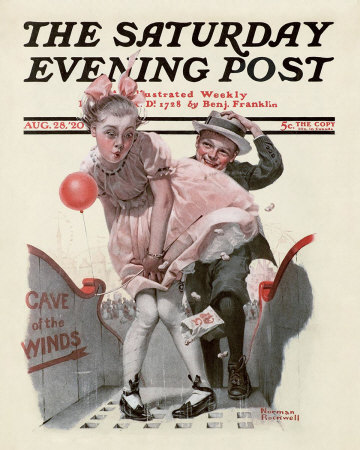
"Likewise, our impulse to dismiss Rockwell’s work as the kitschy waste products of an earlier, naive time allows us to avoid a confrontation that may be somewhat less soothing to our sense of superiority. A false belief in our own sophistication or knowingness is just another form of innocence. We disavow no less than did the most sanitized products of postwar culture. We have simply devised new strategies for doing so, and our ability to see though some of the older ones only makes us patsies for our own." Read More: http://www.press.uchicago.edu/Misc/Chicago/314405.html image: http://images.art.com/images/products/regular/13213000/13213392.jpg
Baudelaire: Besides this charming and singular state, where all the forces are balanced; where the imagination, though enormously powerful, does not drag after it into perilous adventures the moral sense; when an exquisite sensibility is no longer tortured by sick nerves, those councillors-in-ordinary of crime or despair; this marvellous state, I say, has no prodromal symptoms. It is as unexpected as a ghost. It is a species of obsession, but of intermittent obsession; from which we should be able to draw, if we were but wise, the certainty of a nobler existence, and the hope of attaining to it by the daily exercise of our will….Read More: http://www.lycaeum.org/~sputnik/Ludlow/Texts/Rats/poem.html a
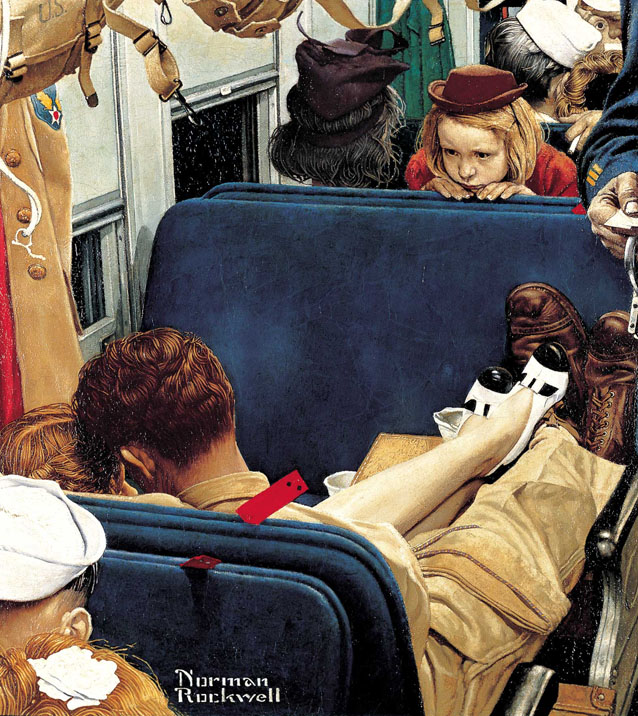
Halpern:I am less interested in the hypocrisies produced by this culture than in the compartmentalization of mind it bespoke—the fact that people could take the products of the innocence industry seriously while also wallowing in less savory fare. Innocence must take on a particularly strained and brittle quality in such circumstances. The best and most interesting products of the innocence industry—and I include Rockwell’s works among them—couldn’t help absorbing, or taking some account of, this vast cultural netherworld and its unwholesome desires. Read More: http://www.press.uchicago.edu/Misc/Chicago/314405.html
Halpern:The philosopher Bernard Williams observed, “One symptom of deep-seated problems of the Freudian kind may be self-deception. But . . . there is a level of self-deception more subconscious than unconscious that can be dealt with by the virtues of accuracy and sincerity. That’s what we have those virtues for.” I would argue that Rockwell’s paintings occupy this level, and do so in complicated ways. Rockwell’s paintings do produce an innocent world, and to that degree they are acts of disavowal. But at the same time, under the guise of innocence, they often present potentially disturbing materials that they then dare the viewer to see and recognize. Rockwell’s work thus lays bare the mechanisms of disavowal. What Rockwell paints is not innocence itself but its manufacture. And his work confronts the viewer with the ethical choice of seeing or not seeing. To be more specific: the “potentially disturbing” materials Rockwell offers to view are often sexual in nature, even perverse. Read More: http://www.press.uchicago.edu/Misc/Chicago/314405.html a
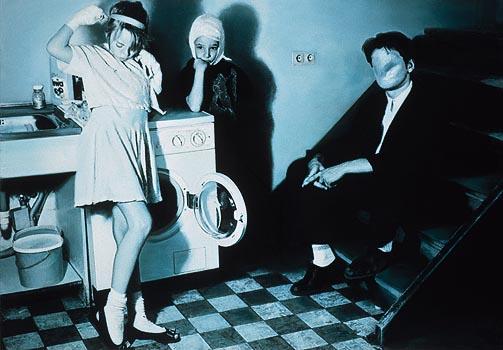
Beyond his treatment of common children's motifs - dolls, toys and ambivalent nymphets- Austrian painter Gottfried Helnwein's vision is shrouded in an aura of enigmatic darkness. With his giant color portraits of stillborn babies; paintings that juxtapose Nazi-era photographs with his own images; and pictures of deformed, abjectly countenanced children swathed in bandages, Helnwein is preoccupied with the indelible suffering that mirrors the more delicate aspects of youth.....Read More: http://scoptophilia.blogspot.com/2010/06/gottfried-helnwein-television-child.html?zx=3a35a2040223b1d4
ADDENDUM:
Rockwell was part of an industry—an innocence industry—along with fellow industrialists like Walt Disney and the director Frank Capra. All three purveyed a view of American culture that was patriotic, optimistic, and imbued with middle-class values, secure in the virtuousness and rightness of the American way. Perhaps all cultures nurse a sense of their own innocence and virtue, and thus engage in disavowal, since no country’s historical record is clean. But American culture is particularly addicted to this sense of itself, and thus has refined disavowal into a high art. Read More: http://www.press.uchicago.edu/Misc/Chicago/314405.html
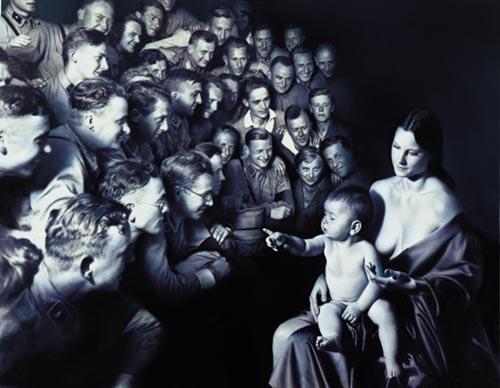
"The Child illustrates a continuance in Helnwein's themes, especially with his large, monochromatic "Epiphany" series. In "Epiphany I: Adoration of the Magi" (1996), a group of SS soldiers gazes adoringly upon a placid looking woman who holds a naked baby on her lap. Part redemptive and part ironic, it's a farcical send-up of the original Nativity tradition. Helnwein used an archived photo in which the person originally in the place of the child was Hitler. While the painting is disconnected from a discrete narrative and one wouldn't necessarily know, upon observation, that the sinister men in the piece are SS soldiers, Helnwein's work is rendered with oppressive reverence that is immediately apparent. According to Helnwein, "There are many connections between the Third Reich and the Christian churches in Austria and German"; the moral complicity of trusted institutions is the source of his brilliant, black satire. " Read More: http://www.helnwein.com/news/update/artikel_1782.html
Consumer society promotes an insidious demagoguery, making people believe that progress can only be achieved by denying the past. In good times, this leads to the desire to purchase new products long before the old ones are worn out. But in times of crisis this conviction can have grave political consequences, inspiring movements that promote ritual purification. Rather than resisting consumerism, fascism bears witness to its transcendence, the moment when political choices are presented like items in a shop window.Read More: http://zeek.forward.com/articles/116888/
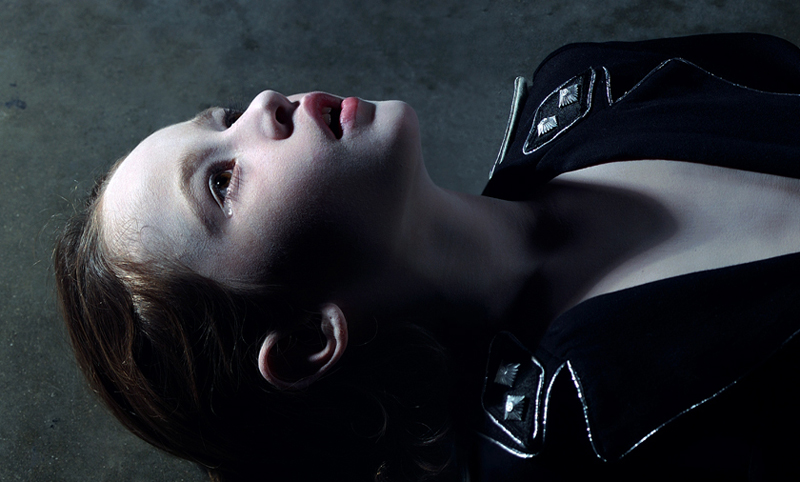
Sean Penn: Well, the world is a haunted house, and Helnwein at times is our tour guide through it. I think in anything that is really relevant and emotional art, there is some kind of a mirror that people experience. Read More: http://helnwein-newsletter.com/helnwein%20-%20the%20silence%20of%20innocence/index_en.html
———————————————————————————–
Technologies of mass reproduction undo the value of art, but in so doing bring it into a new use, with new potentialities. Art is liquidated in order to prepare for what Benjamin calls its “exposed resurrection.” Yet importantly, such a resurrection implies risk as well as possibility. On the one hand, it enables a distraction of
affect from ‘the political’ that verges towards fascism. Benjamin had rightly feared that aesthetic reifications of
tradition—‘kitsch’ objects and ideals mobilised in film—would effectively assist the Nazi party to commandeer all sense of community in Germany. Technology destabilises tradition, and both ‘ends’ of the cultural spectrum resist this move: emissaries of ‘high culture’ make melancholic appeal to an ‘aura’ only discovered at the moment of its disappearance; and ‘low culture’ invents kitsch—ornaments and household knick-knacks that crudely and sentimentally represent an older order. As Goebbels was aware, kitsch is more successful than art pour l’art in recruiting a nostalgia for tradition: it takes up the new technology ironically—holding in suspension the juxtaposition between new technology and old art forms—and thus is able to harness sentiment to a radical, yet backward-looking, politics. Read More: http://parrhesiajournal.org/parrhesia11/parrhesia11_faulkner.pdf





 COMMENTS
COMMENTS